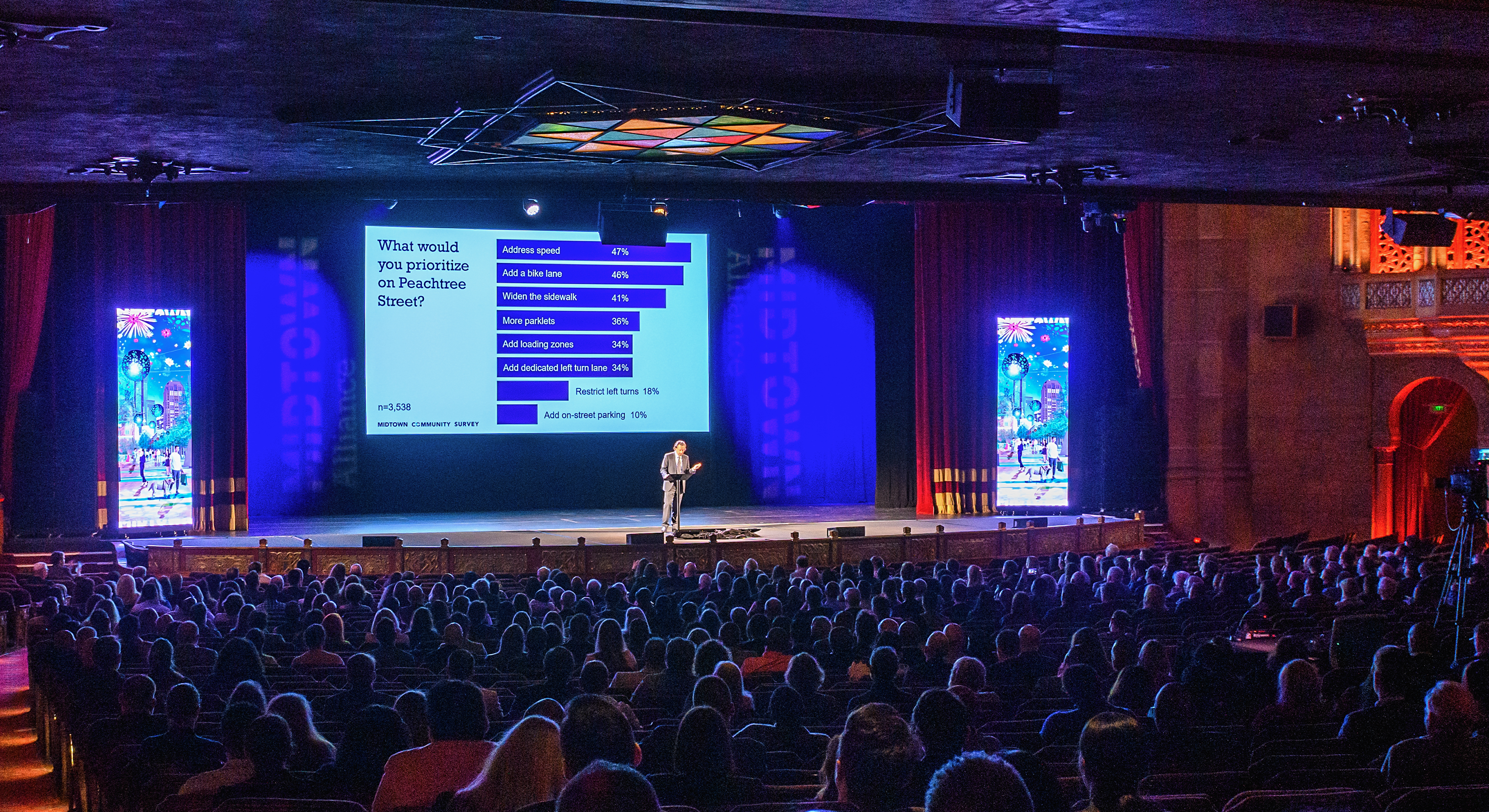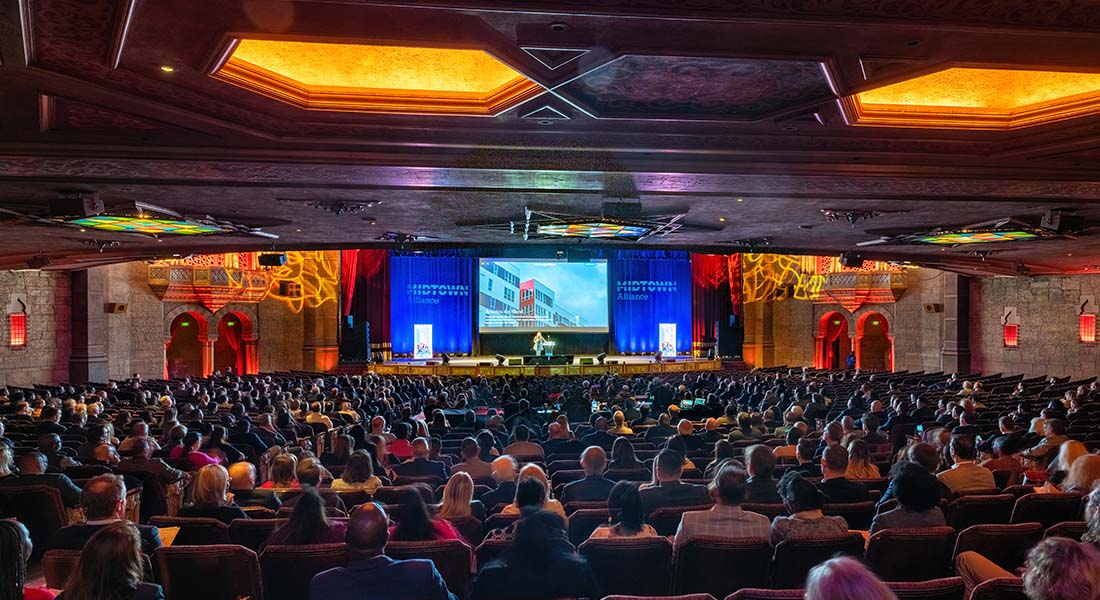Midtown Alliance Releases 2019 Community Survey Topline Results
Takeaways include desire for more transportation choices, more public spaces
Published: 07/02/19
Midtown Alliance recently wrapped up its 2019 Midtown Community Survey, where we asked residents, workers and visitors to weigh in on a number of topics ranging from transportation to public safety, park spaces and more.
Since the last time we conducted the survey in 2016, much has changed about the district:

More than 5,000 respondents stepped up to complete the survey, making it one of the largest community surveys of its kind east of the Mississippi River, and your answers will help us inform our programs and strategies. Here are some of the key findings from our survey and how we plan to use them to chart Midtown’s future.
Investment in Walking Ranked as No. 1 Transportation Priority
94% of survey respondents agree that “as Midtown’s population continues to grow, the district is no longer just a place to drive through quickly.”
Respondents’ transportation priorities continued to show strong support for infrastructure investment that accommodates alternatives to cars. Walking ranked No. 1 among modes, with 96% of respondents saying it should be the highest priority. But even controversial e-scooters outranked desire for investment in projects that support motor vehicles. Read the results here.
Transportation options ranked by priority for future investment (“very high/high”), according to 2019 Midtown Community Survey respondents:

Findings Validate Ongoing Work on Corridor Improvements
Midtown Alliance already has projects in the planning stages that reflect these priorities. For example, the West Peachtree and Spring Street “Complete Street” Projects will increase safety and accessibility for all street users by repurposing one travel lane for a protected one-way bike lane, upgrading sidewalks to be ADA accessible and adding lighting.
Survey respondents overwhelmingly indicated their approval, with 90% agreeing that the “function and feel of Spring and West Peachtree Streets should be improved to more effectively serve people walking, biking and riding e-scooters, as well as motorists.”
“It’s not surprising to see that people who spend time in Midtown desire more projects that tailor to safe, multi-modal options,” said Midtown Alliance Transportation and Sustainability Director Dan Hourigan. “It’s nice to know the survey results continue to validate our work.”
West Peachtree and Spring Streets Complete Streets Project are still in the concept phase, and will need approvals from agency partners, including GDOT.
These Community Survey findings will reinforce the community’s priorities on future transportation projects as these projects advance.
Another near-term set of projects, called Last Mile Intersections, aim to improve safety for people on foot and improve connections to transit by providing more safe and accessible street crossings. For these projects, the City of Atlanta and Midtown Alliance have been awarded funding to install five new traffic signals and two pedestrian-actuated signals. The Last Mile projects are fully designed and funded, and procuring a construction contractor is the next step towards construction. Other fully funded transportation projects include Juniper Street Complete Street Project, 10th Street Bridge Enhancements and Piedmont Avenue Complete Street Project.
More Small Parks and Plazas Desired in Midtown
Although the district borders Atlanta’s largest green space, Piedmont Park, many Midtown residents currently don’t live within a 10-minute walk of a park. We asked how desirable it would be for Midtown to add new, smaller parks and permanent plazas throughout the district, separate from Piedmont Park, and 95% of respondents responded that these smaller parks would be desirable.
If these smaller parks or plazas were created, respondents said their most desired amenities would be places to sit, scheduled live music and entertainment, and places to buy food and drinks.
In 2018, Midtown Alliance introduced a vision for a pocket park at Peachtree Street and Peachtree Place, with a working title called Commercial Row Commons. The project would benefit the community by modifying the intersection to improve safety and connectivity and by repurposing public space for local retailers and the neighborhood as a whole.
“Gathering spaces like Commercial Row Commons are valuable public amenities in dense urban areas,” said Midtown Alliance Director of Urban Design Ginny Kennedy. “They give people the chance to interact with their neighbors and enrich the experience of city living. We’re thrilled the community told us they want more.”
Commercial Row Commons will be created on land owned by the Atlanta History Center, and the 26 feet of Peachtree Place right-of-way that will be repurposed is owned by the City of Atlanta. Midtown Alliance will create and maintain the park space, and would also work with the Atlanta History Center to find opportunities for ongoing programming in the plaza.
Other possible methods for establishing parks and plazas include buying land — an expensive but permanent commitment to the district — and working with existing landowners to create art installations or green spaces.
In an area developing as rapidly as Midtown, there is a sense of urgency to secure park space for people before the options are gone.
Sentiment Around Public Safety is Improving
Overall, 94% of the crime that takes place in Midtown is nonviolent property crime. Car break-ins remain the most prevalent issue, and Midtown Blue has intensified its efforts to work with parking facility managers on safety audits.
The 2019 Community Survey determined that sentiment around public safety is improving, with 60% of respondents describing Midtown as safe from crime, compared to 50% in 2016 and 43% in 2013.
Compared to 2016 survey results, the number of respondents who describe Midtown as safe from crime increased substantially, including a 30 percent increase among those who live in Midtown and a 38 percent increase among those who both live and work in Midtown. View results here.

Although these findings show a noteworthy improvement, more work remains to be done. Most survey respondents said they are only 'somewhat' or 'not at all' familiar with Midtown Blue’s supplemental services, which include:
- Conducting regular patrols on foot, Segway, bicycle and in vehicles
- Acting as first responders in emergency situations
- Monitoring high-definition cameras that monitor the public right-of-way
- Making routine visits to ground-floor business and residential property managers
- Performing early morning wellness checks and waking up homeless persons in the public right-of-way
Community Enthusiasm Remains Strong
Midtown Alliance gave residents, workers and visitors who spend time in the district a homework assignment. You not only gave us 10 minutes of your time on average, but you also indicated you have a strong personal attachment toward Midtown. In 2019, 79 percent of the people who live and work in Midtown said they feel a strong sense of community or personal attachment to the district.
“With so many new faces in Midtown since we last conducted the survey, it was time to check in with the community on where we should be focusing our programs as we work together to create an exceptional district,” said Midtown Alliance President and CEO Kevin Green. “Indeed, half of the respondents to this survey had either lived or worked in the district fewer than five years. We were very pleased with the community’s response, and passion, in building Midtown’s future.”
Full results from the 2019 Midtown Community Survey, including analysis of open-ended responses and commuter data, are available here in our Resource Center.




